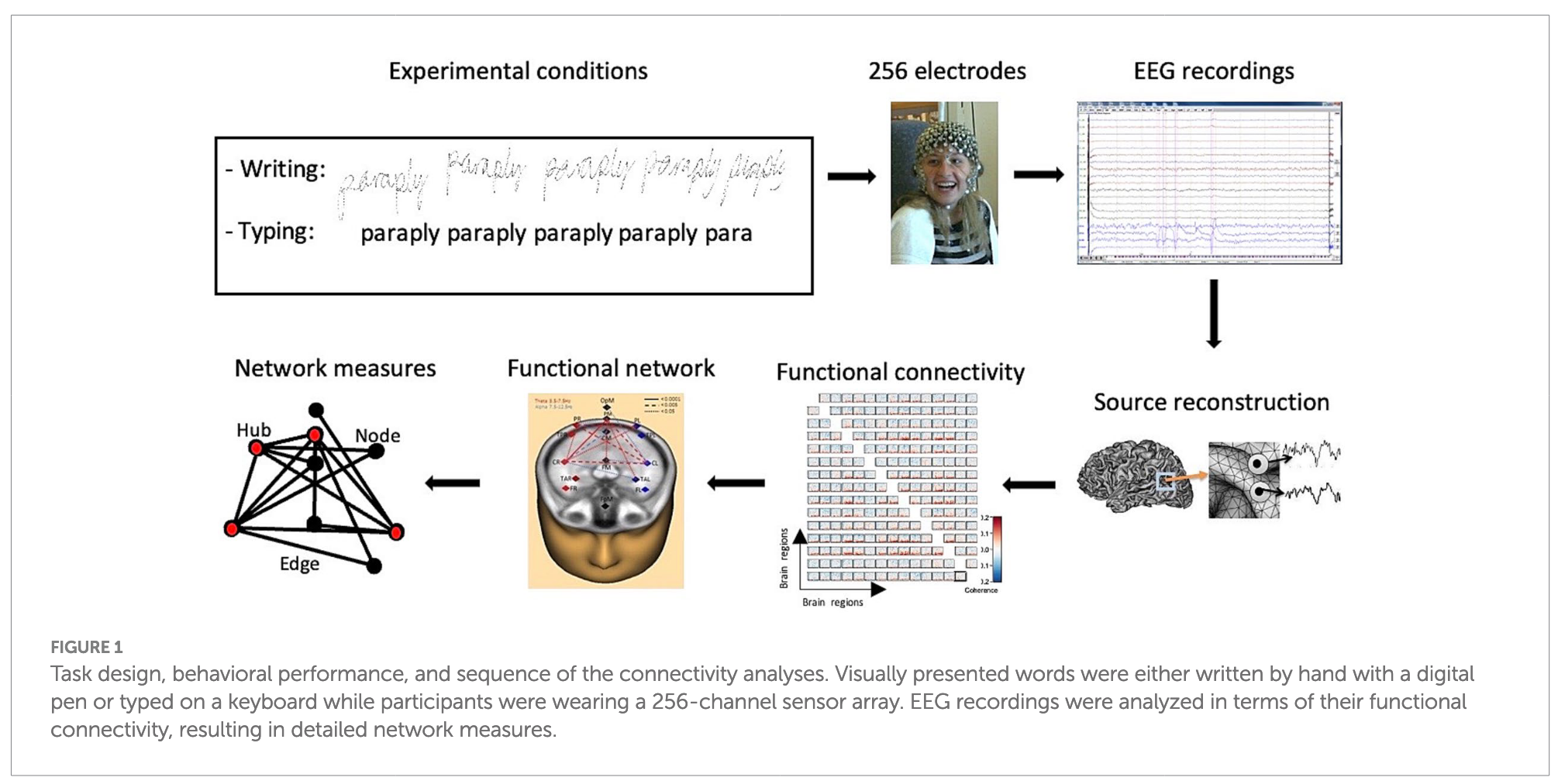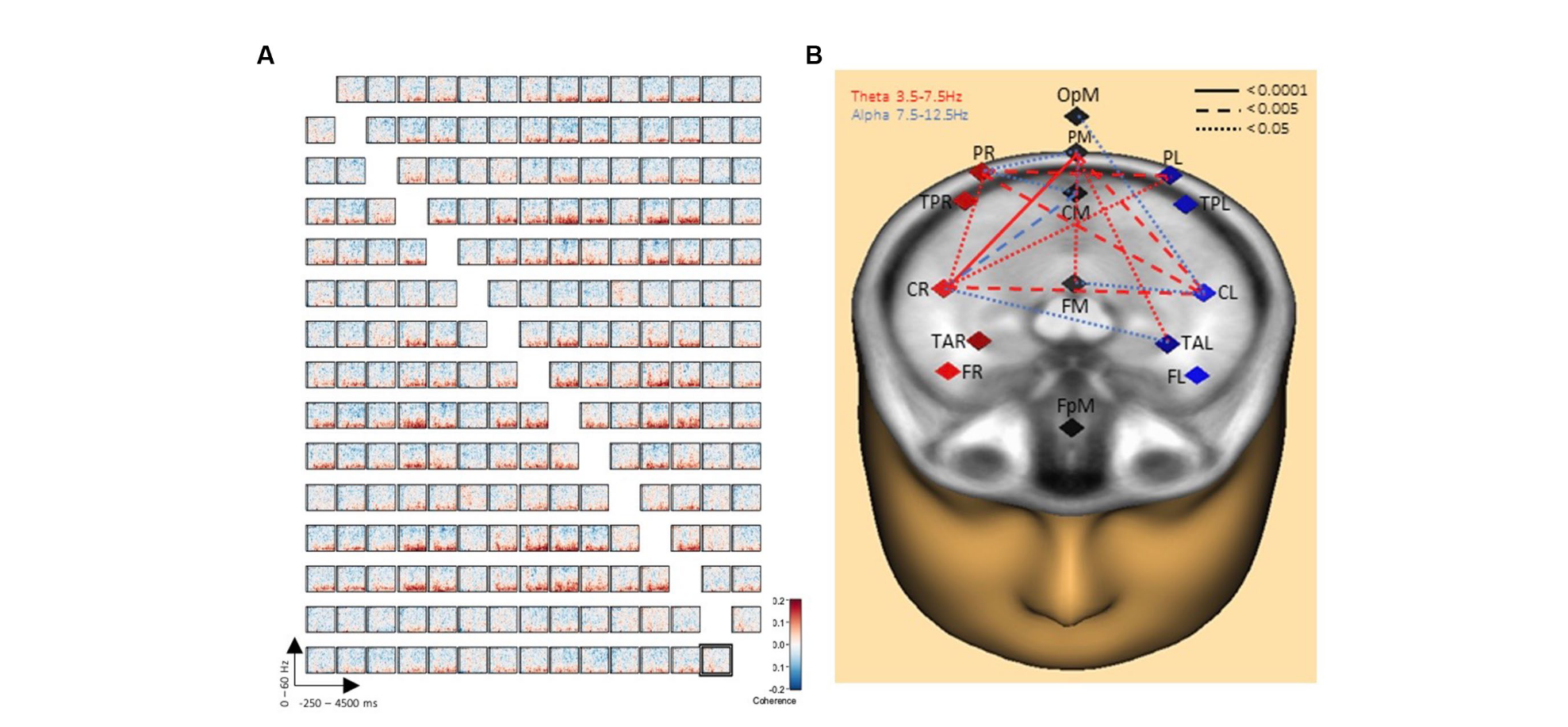✍️ Handwriting but not typewriting leads to widespread brain connectivity
A recent EEG-study from our lab showed that drawing by hand causes more activity and involves larger areas in the brain as opposed to typing on a keyboard.
The participants used a digital pen to write in cursive by hand directly on the touchscreen, and a keyboard to typewrite the presented words.
Before each trial, the instruction write or type appeared before one of the target words appeared, and the participants were given 25 s to either write by hand or type the word multiple times, separated by a space.
EEG data were recorded only during the first 5 s of each trial.
A Geodesic Sensor Net (GSN; Tucker et al., 1994) with 256 evenly distributed electrodes was used to record EEG activity from the participant’s scalp at 500 Hz. The signals were amplified using a highinput EGI amplifier (Picton et al., 2000).

Figure 1. Task design.

Figure 3. Connectivity results of writing over typing.
(A) Grand average connectivity matrix results show widespread theta/alpha coherence results (in red) between PL, PM, PR and CL, CM, CR brain regions when writing by hand, but not when typing. The y-axes display frequencies from 2 to 60Hz. The x-axes display the time interval from baseline to 4,500ms of recordings of the trial for all involved brain regions. The signal magnitude (coherence) reflects the estimated neural connectivity between the various brain regions during the writing condition compared to baseline activity (−250 to 0ms).
(B) Further illustration of connectivity patterns revealing a concentration of 16 significant connections for handwriting compared to typewriting. Connection lines in red indicate connectivity in the theta range whereas lines in blue indicate connectivity in the alpha range. Levels of significance in connectivity strength for handwriting, but not for typewriting are further indicated by solid (<0.0001), dashed (<0.005), and dotted (<0.05) connection lines.

FIGURE 5. The adjacency matrix for handwriting.
(A) Hub, nodes, and edges of a simplified theoretical network.
(B) Brain connectivity network of handwriting compared to typewriting in this experiment.
(C) Hubs (in red, ≥ 4 departures/arrivals) and nodes (in black, ≤ 3 departures/arrivals) interacting between brain regions PL, PM, PR and CL, CM, CR show widespread theta/alpha connectivity patterns when writing by hand, but not when typing.
The present findings revealed increased connectivity for handwriting over typewriting, suggesting that different underlying cognitive processes are involved in the two tasks.
As increased connectivity in the brain was observed only when writing by hand and not when simply pressing keys on the keyboard, our findings can be taken as evidence that handwriting promotes learning.
The theta/alpha connectivity patterns found in the present study may indicate that different neural networks are involved in handwriting and typewriting.
Interestingly, whereas connectivity in the alpha band is considered highly task-specific and is said to correspond to long-term memory performance, theta connectivity seems to be related to working memory and the ability to apprehend novel information.
Thus, the enhanced brain connectivity for handwriting appears not to be related to differences in muscular involvement.
It has also been proposed that hippocampal activity is reflected within the theta band (Klimesch et al., 1994), adding further support for the benefits of handwriting in terms of learning and memory formation.
Lower frequencies are considered especially suited for facilitating communication over longer distances in the brain, and are often reported to "gate" the occurrence of faster oscillations, for example when theta oscillations in humans are proposed to gate gamma (> 30 Hz) oscillations.
In general, this theta-to-gamma cross-frequency coupling can be linked to gamma networks desynchronizing and theta networks synchronizing during encoding, retrieval, and episodic memory formation.
Others have suggested that theta connectivity activity (see Figure 3) is positively correlated with a brain region’s gamma power, suggesting a potent low-frequency mechanism for communication between brain regions.
Handwriting requires fine motor control over the fingers, and it forces students to pay attention to what they are doing. Typing, on the other hand, requires mechanical and repetitive movements that trade awareness for speed. Our results reveal that whenever handwriting movements are included as a learning strategy, more of the brain gets stimulated, resulting in the formation of more complex neural network connectivity. It appears that the movements related to typewriting do not activate these connectivity networks the same way that handwriting does. The concurrent spatiotemporal pattern from vision, motor commands, and proprioceptive feedback provided through fine hand and finger movements, is lacking in typewriting, where only a simple key press is required to produce the entire wanted form (Longcamp et al., 2006; James, 2010; Vinci-Booher et al., 2016, 2021). In the present study, participants only used their right index finger for typing to prevent undesired crossover effects between the two hemispheres.
Thus, the ongoing substitution of handwriting by typewriting in almost every educational setting may seem somewhat misguided as it could affect the learning process in a negative way (Alonso, 2015; Mangen and Balsvik, 2016; Arnold et al., 2017). The present findings suggest that the intricate and precisely controlled handwriting movements have a beneficial impact on the brain’s connectivity patterns related to learning and remembering. The present study did not find evidence of such positive activation patterns when using a keyboard.
source: https://doi.org/10.3389/fpsyg.2023.1219945
#neuroscience #EEG #handwriting #connectivity #brainActivity #brainNetworks